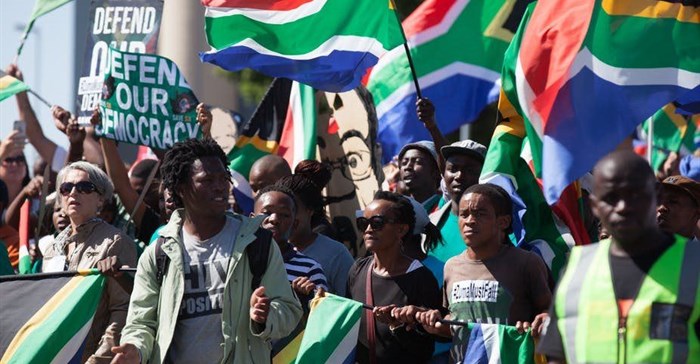
South Africa has seen a steady rise in the number of protests Shutterstock
Considered in conjunction with the country’s dismal education outcomes, which the IMF found are perpetuating inequality and contributing to the country’s low economic growth, and the possibility of a ratings downgrade, the outlook isn’t auspicious.
Academics and political leaders have long warned that a combination of high youth unemployment, poor educational outcomes, and high inequality levels will eventually explode into large-scale social disorder. There has indeed been a steady rise in the number of protests. The country is now classified as a fragile state by Corruption Watch.
However, the recent elections provide two interesting pointers. The first was the extremely low voter turnout of just 49%. The second was a near doubling of the Economic Freedom Fighters’ (EFF) share of the vote, from 6.4% in the 2014 poll to 10.8% in 2019. Taken together, these factors suggest that South Africa’s vulnerable citizens are frustrated with the established political parties. However, they are not as yet widely attracted to the potential re-distributive policies of populists.
This raises a question. If South Africa’s political and socioeconomic stability are so fractured, how has the country managed to defuse the ‘ticking time-bomb’ for so long?
Balancing act
According to economists Daron Acemoglu and James Robinson, the democratic system attempts to balance two forces. The revolutionary redistributive pressure of the citizens on the one side, against the repressive power of the elites on the other. But high levels of inequality interfere with democratic consolidation and make revolutionary change more attractive. For self-preservation reasons, elites must stomach high tax rates, or land and capital redistribution.
In the first decade of democracy in South Africa, the country followed a path of financial and trade liberalisation as it re-engaged with the global economy. The relatively strong economic performance then enabled government to placate the formerly disenfranchised through redistributive policies. The key ones were black economic empowerment and social grants. This was underpinned by an effective tax system.
Under pressure
Unfortunately, the ability to balance the insider-outsider economy with social support was then significantly rocked by two major disruptions. The first was the global financial crisis. The second was the misrule of President Jacob Zuma.
Over the next decade, state capture and crony capitalism, coupled with economic decline, weakened the middle class and entrenched meritocracy. In turn this raised pressure for greater re-distributive policies, both among factions of the ANC and eventually with the emergence of the EFF. The dire state of private sector investment and growth meant that the increased redistributive pressure was initially alleviated by public sector employment creation. This grew from 2.2 million in 2008 to 2.7 million by the end of 2014.
But in recent years, as the corrosive effects of corruption took hold, economic decay has become entrenched. This has resulted in declining tax revenues and spiralling state owned enterprise debt. Political factionalism and policy paralysis have also increased.
Consequently, government no longer has the financial wherewithal to fund the dysfunctional and indebted state-owned enterprises. These enterprises have been associated with the failed developmental state ideology. Weakened government finances have also made it difficult to provide social support via public sector employment.
As a result, the African National Congress (ANC) has increasingly turned to desperate policy debates such as expropriation of land without compensation, prescribed assets, off-shore income taxes, and changing the mandate of the South African Reserve Bank to print more money.
To make matters worse, the global economy is experiencing the instability associated with trade wars and populism. South Africa’s economy will therefore likely continue to perform worse than the slowing global economy.
Tough choice ahead
If the country is to survive its current crisis, government will need to undertake two difficult tasks simultaneously. It will need to:
ul>
refocus on resuscitating inclusive growth by supporting the informal economy and removing red tape for small, medium and micro-sized enterprises,
Read more:
Employed but still poor: the state of low-wage working poverty in South Africa
- provide policy certainty,
- allow the private sector to invest in state-owned enterprises, and
- facilitate the move away from a fossil-fuel based mining economy.
At the same time, government will also have to free up budgetary resources by reducing the size of the bloated public sector and withstanding trade union wage demands.
If the inclusion of left-leaning ministers in the new cabinet and the recent contradictory policy statements from ANC leaders are a precursor to continued fractional government paralysis, then the country can expect even more economic instability and policy stagnation ahead.
Eventually, this will lead to significant socio-political stress as the private sector disengages and disinvests. The public sector will collapse under its own weight, and disenfranchised citizens will clutch at populist straw men.
Given the dysfunctional state of the ANC alliance and the over-arching quest for ‘unity’, it is apparent that President Cyril Ramaphosa must make a choice between saving the ANC alliance or saving the country. He can’t save both. Let’s hope he chooses wisely.
This article is republished from The Conversation under a Creative Commons license. Read the original article.


































